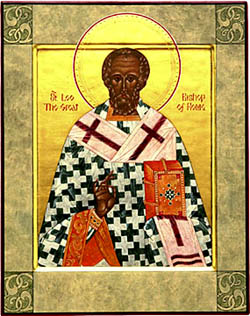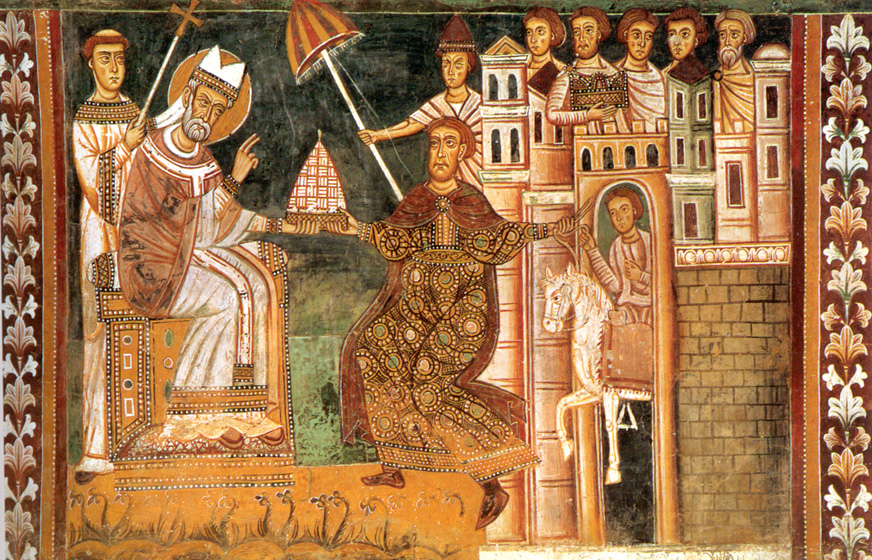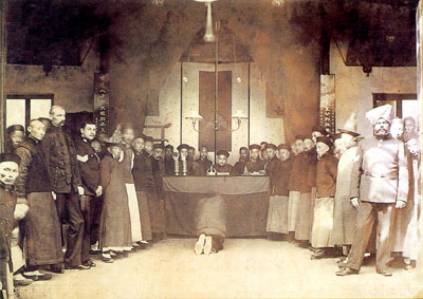|
San Paolo Fuori Le Mura
The Papal Basilica of Saint Paul Outside the Walls ( it, Basilica Papale di San Paolo fuori le Mura), commonly known as Saint Paul's Outside the Walls, is one of Rome's four major papal basilicas, along with the basilicas of Saint John in the Lateran, Saint Peter's, and Saint Mary Major, as well as one of the Seven Pilgrim Churches of Rome. The Basilica is within Italian territory, but the Holy See owns the Basilica in a regime of extraterritoriality, with Italy recognizing its full ownership and conceding it "the immunity granted by international law to the headquarters of the diplomatic agents of foreign States". James Michael Harvey was named Archpriest of the basilica in 2012. History The basilica was founded by the Roman Emperor Constantine I over the burial place of Paul of Tarsus, where it was said that, after the apostle's execution, his followers erected a memorial, called a ''cella memoriae''. This first basilica was consecrated by Pope Sylvester in 324. In ... [...More Info...] [...Related Items...] OR: [Wikipedia] [Google] [Baidu] |
Catholic Church
The Catholic Church, also known as the Roman Catholic Church, is the largest Christian church, with 1.3 billion baptized Catholics worldwide . It is among the world's oldest and largest international institutions, and has played a prominent role in the history and development of Western civilization.O'Collins, p. v (preface). The church consists of 24 ''sui iuris'' churches, including the Latin Church and 23 Eastern Catholic Churches, which comprise almost 3,500 dioceses and eparchies located around the world. The pope, who is the bishop of Rome, is the chief pastor of the church. The bishopric of Rome, known as the Holy See, is the central governing authority of the church. The administrative body of the Holy See, the Roman Curia, has its principal offices in Vatican City, a small enclave of the Italian city of Rome, of which the pope is head of state. The core beliefs of Catholicism are found in the Nicene Creed. The Catholic Church teaches that it is the on ... [...More Info...] [...Related Items...] OR: [Wikipedia] [Google] [Baidu] |
Patriarch Of The West
Patriarch of the West ( la, Patriarcha Occidentis) was, on several occasions between AD 450 and 2006, one of the official titles of the bishop of Rome, as patriarch and highest authority of the Latin Church. The title no longer appears among the official ones, starting from the publication of the 2006 ''Annuario Pontificio''. History The origin of the definition of the patriarch of the West is linked to the disestablishment of the ancient system based on the three apostolic centers of Rome, Antioch (both founded by Saint Peter) and Alexandria (founded by Saint Mark, the disciple of Peter), and the establishment, despite papal opposition, of the new Pentarchy, with the First Council of Constantinople in 381 and the Council of Chalcedon in 451, which led to the elevation of the Patriarchate of Constantinople and Jerusalem. In this system, with the exception of Rome, the other four patriarchates fell under the authority of the Byzantine Empire and came to correspond with territori ... [...More Info...] [...Related Items...] OR: [Wikipedia] [Google] [Baidu] |
Old Saint Peter's Basilica
Old St. Peter's Basilica was the building that stood, from the 4th to 16th centuries, where the new St. Peter's Basilica stands today in Vatican City. Construction of the basilica, built over the historical site of the Circus of Nero, began during the reign of Emperor Constantine I. The name "old St. Peter's Basilica" has been used since the construction of the current basilica to distinguish the two buildings. History Construction began by orders of the Roman Emperor Constantine I between 318 and 322, and took about 40 years to complete. Over the next twelve centuries, the church gradually gained importance, eventually becoming a major place of pilgrimage in Rome. Papal coronations were held at the basilica, and in 800, Charlemagne was crowned emperor of the Holy Roman Empire there. In 846, Saracens sacked and damaged the basilica. The raiders seem to have known about Rome's extraordinary treasures. Some holy—and impressive—basilicas, such as St. Peter's Basilica, w ... [...More Info...] [...Related Items...] OR: [Wikipedia] [Google] [Baidu] |
Pope Leo I
Pope Leo I ( 400 – 10 November 461), also known as Leo the Great, was bishop of Rome from 29 September 440 until his death. Pope Benedict XVI said that Leo's papacy "was undoubtedly one of the most important in the Church's history." Leo was a Roman aristocrat, and was the first pope to have been called "the Great". He is perhaps best known for having met Attila the Hun in 452 and persuaded him to turn back from his invasion of Italy. He is also a Doctor of the Church, most remembered theologically for issuing the Tome of Leo, a document which was a major foundation to the debates of the Council of Chalcedon, the fourth ecumenical council. That meeting dealt primarily with Christology and elucidated the orthodox definition of Christ's being as the hypostatic union of two natures, divine and human, united in one person, "with neither confusion nor division". It was followed by a major schism associated with Monophysitism, Miaphysitism and Dyophysitism. He also contributed signi ... [...More Info...] [...Related Items...] OR: [Wikipedia] [Google] [Baidu] |
Pope Innocent I
Pope Innocent I ( la, Innocentius I) was the bishop of Rome from 401 to his death on 12 March 417. From the beginning of his papacy, he was seen as the general arbitrator of ecclesiastical disputes in both the East and the West. He confirmed the prerogatives of the Archbishop of Thessalonica, and issued a decretal on disciplinary matters referred to him by the Bishop of Rouen. He defended the exiled John Chrysostom and consulted with the bishops of Africa concerning the Pelagian controversy, confirming the decisions of the African synods. The Catholic priest-scholar Johann Peter Kirsch, 1500 years later, described Innocent as a very energetic and highly gifted individual "...who fulfilled admirably the duties of his office". Family background According to his biographer in the ''Liber Pontificalis'', Innocent was a native of Albano Laziale and the son of a man called Innocentius, but his contemporary Jerome referred to him as the son of the previous pope, Anastasius I in a lette ... [...More Info...] [...Related Items...] OR: [Wikipedia] [Google] [Baidu] |
Theodosius I
Theodosius I ( grc-gre, Θεοδόσιος ; 11 January 347 – 17 January 395), also called Theodosius the Great, was Roman emperor from 379 to 395. During his reign, he succeeded in a crucial war against the Goths, as well as in two civil wars, and recognized the Catholic orthodoxy of Nicene Christians as the Roman Empire's state religion. Theodosius was the last emperor to rule the entire Roman Empire before its administration was permanently split between two separate courts (one western, the other eastern). Born in Hispania, Theodosius was the son of a high-ranking general, Theodosius the Elder, under whose guidance he rose through the ranks of the Roman Army. Theodosius held independent command in Moesia in 374, where he had some success against the invading Sarmatians. Not long afterwards, he was forced into retirement, and his father was executed under obscure circumstances. Theodosius soon regained his position following a series of intrigues and executions ... [...More Info...] [...Related Items...] OR: [Wikipedia] [Google] [Baidu] |
Pope Sylvester I
Pope Sylvester I (also Silvester, 285 – 31 December 335) was the bishop of Rome from 31 January 314 until his death. He filled the see of Rome at an important era in the history of the Western Church, yet very little is known of him. The accounts of his pontificate preserved in the seventh- or eighth-century '' Liber Pontificalis'' contain little more than a record of the gifts said to have been conferred on the church by Constantine I, although it does say that he was the son of a Roman named Rufinus. His feast is celebrated as Saint Sylvester's Day, on 31 December in Western Christianity, and on 2 January in Eastern Christianity. Pontificate Large churches were founded and built during Sylvester I's pontificate, including Basilica of St. John Lateran, Basilica of the Holy Cross in Jerusalem, Old St. Peter's Basilica and several churches built over the graves of martyrs. Sylvester did not attend the First Council of Nicaea in 325, where the Nicene Creed was formulated, but ... [...More Info...] [...Related Items...] OR: [Wikipedia] [Google] [Baidu] |
Paul Of Tarsus
Paul; grc, Παῦλος, translit=Paulos; cop, ⲡⲁⲩⲗⲟⲥ; hbo, פאולוס השליח (previously called Saul of Tarsus;; ar, بولس الطرسوسي; grc, Σαῦλος Ταρσεύς, Saũlos Tarseús; tr, Tarsuslu Pavlus; la, Paulus Tarsensis AD), commonly known as Paul the Apostle and Saint Paul, was a Christian apostle who spread the teachings of Jesus in the first-century world. Generally regarded as one of the most important figures of the Apostolic Age, he founded several Christian communities in Asia Minor and Europe from the mid-40s to the mid-50s AD. According to the New Testament book Acts of the Apostles, Paul was a Pharisee. He participated in the persecution of early disciples of Jesus, possibly Hellenised diaspora Jews converted to Christianity, in the area of Jerusalem, prior to his conversion. Some time after having approved of the execution of Stephen, Paul was traveling on the road to Damascus so that he might find any Christians ... [...More Info...] [...Related Items...] OR: [Wikipedia] [Google] [Baidu] |
Constantine I (emperor)
Constantine I ( , ; la, Flavius Valerius Constantinus, ; ; 27 February 22 May 337), also known as Constantine the Great, was Roman emperor from AD 306 to 337, the first one to convert to Christianity. Born in Naissus, Dacia Mediterranea (now Niš, Serbia), he was the son of Flavius Constantius, a Roman army officer of Illyrian origin who had been one of the four rulers of the Tetrarchy. His mother, Helena, was a Greek Christian of low birth. Later canonized as a saint, she is traditionally attributed with the conversion of her son. Constantine served with distinction under the Roman emperors Diocletian and Galerius. He began his career by campaigning in the eastern provinces (against the Persians) before being recalled in the west (in AD 305) to fight alongside his father in Britain. After his father's death in 306, Constantine became emperor. He was acclaimed by his army at Eboracum (York, England), and eventually emerged victorious in the civil wars against emperors ... [...More Info...] [...Related Items...] OR: [Wikipedia] [Google] [Baidu] |
Extraterritoriality
In international law, extraterritoriality is the state of being exempted from the jurisdiction of local law, usually as the result of diplomatic negotiations. Historically, this primarily applied to individuals, as jurisdiction was usually claimed on peoples rather than on lands. Extraterritoriality can also be partly applied to physical places, such as the immunity granted to diplomatic missions, military bases of foreign countries, or offices of the United Nations. The three most common cases recognized today internationally relate to the persons and belongings of foreign heads of state and government, the persons and belongings of ambassadors and other diplomats, and ships in international waters. Forms In the past, pre-modern states generally claimed sovereignty over persons, creating something known as personal jurisdiction. As people move between borders, this led, in the framework of a territorial jurisdiction, to certain persons being under the laws of countries in w ... [...More Info...] [...Related Items...] OR: [Wikipedia] [Google] [Baidu] |
Holy See
The Holy See ( lat, Sancta Sedes, ; it, Santa Sede ), also called the See of Rome, Petrine See or Apostolic See, is the jurisdiction of the Pope in his role as the bishop of Rome. It includes the apostolic episcopal see of the Diocese of Rome, which has ecclesiastical jurisdiction over the Catholic Church and the sovereign city-state known as the Vatican City. According to Catholic tradition it was founded in the first century by Saints Peter and Paul and, by virtue of Petrine and papal primacy, is the focal point of full communion for Catholic Christians around the world. As a sovereign entity, the Holy See is headquartered in, operates from, and exercises "exclusive dominion" over the independent Vatican City State enclave in Rome, of which the pope is sovereign. The Holy See is administered by the Roman Curia (Latin for "Roman Court"), which is the central government of the Catholic Church. The Roman Curia includes various dicasteries, comparable to ministries and ex ... [...More Info...] [...Related Items...] OR: [Wikipedia] [Google] [Baidu] |
Seven Pilgrim Churches Of Rome
As the home of the Pope and the Catholic curia, as well as the locus of many sites and relics of veneration related to apostles, saints and Christian martyrs, Rome had long been a destination for pilgrims. The Via Francigena was an ancient pilgrim route between England and Rome. It was customary to end the pilgrimage with a visit to the tombs of Saints Peter and Paul. Periodically, some were moved to travel to Rome for the spiritual benefits accrued during a Jubilee. These indulgences sometimes required a visit to a specific church or churches. Pilgrims need not visit each church. Origin of the itinerary The tradition of visiting all seven churches was started by Philip Neri around 1553 in order to combine conviviality and the sharing of a common religious experience through discovering of the heritage of the early Saints. Neri drew up an itinerary that included visits to St. Peter's Basilica, then St. Paul Outside-the-Walls, St. Sebastian's, St. John Lateran, Holy Cross-in-Jerusa ... [...More Info...] [...Related Items...] OR: [Wikipedia] [Google] [Baidu] |
_(14743552956).jpg)
.jpg)





.jpg)



